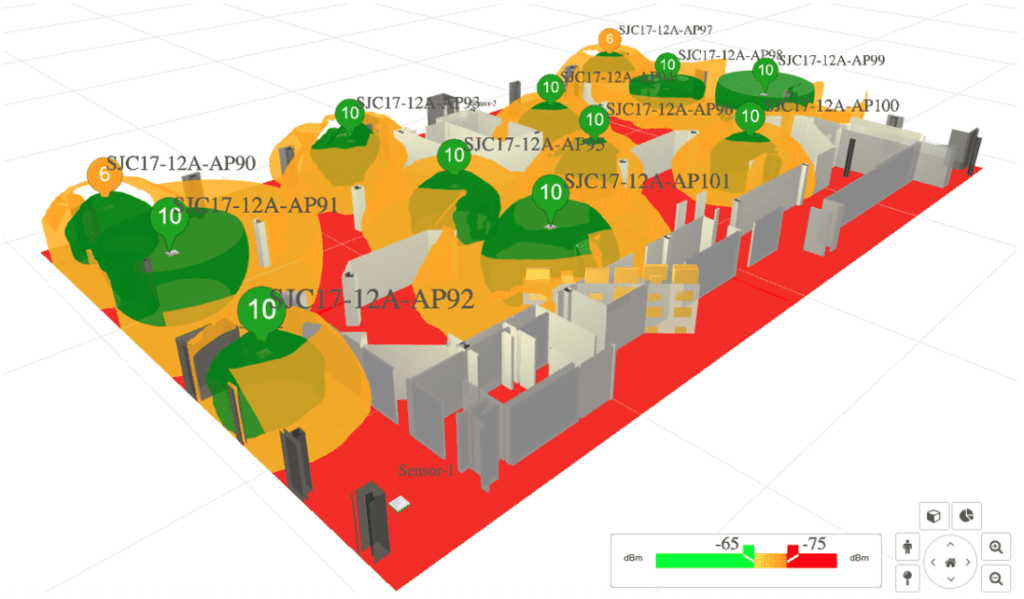Cisco has added new functionality for Wi-Fi radio frequency network planning and visibility to its portfolio that provides a “visual 3D immersive experience,” similar to a first-person video game perspective.
Todd Untrecht, head of product management and go-to-market strategy for Cisco DNA Center, said that the new software release that includes the 3D analyzer capability builds upon the company’s efforts to bring artificial intelligence and machine-learning-based tools to network planning and monitoring, but also to focus ultimately, on the human experience of a wireless network. “Applications and infrastructure, at the end of the day, are just proxies for that human experience,” he said.
As Cisco focuses on supporting customers in becoming more agile through digital transformation, he said, the first transition is often simply getting a network set up and working well in order to build upon it. In the 3D Wireless Analyzer tool, which is part of Cisco’s DNA Center new release 2.2.3, he says the company is giving customers “the super power of teleportation.”
The 3D analyzer can give multiple views, including a first-person moving walk-through of a space—similar to a first-person video game perspective, allowing users to “fly in” and “walk” around a space while seeing a three-dimensional heat map that reflects RF signal strength around the space. In pandemic days, Untrecht said, when network personnel may not be able to visit a site in-person, such a tool is “massively powerful.”

“It can give you RF coverage at different elevations,” he added. “Wireless 2D maps have been around for awhile. But the idea of a 3D map now gives you that third dimension, because at the end of the day, that’s where we all live: In 3D spaces. So when you have warehouse environments that have multiple heights, they have APs at the top of the ceilings that can be 43 feet tall. The RF coverage is going to be different at different levels and at the floor. That becomes super important.”
Cisco has integration with third party tools such as Ekahau, which enables 2D maps plus metadata to be imported, and then the 3D analyzer translates that metadata into 3D visualization, as well as pulling in real-time data from APs.
RF leakage between floors is a common problem and an important factor to be able to pinpoint, Untrecht said, and the analyzer can also account for attenuation and the difference, say, between cubicle walls and concrete walls, as well as pinpoint interference or high traffic areas. It can also help with troubleshooting and setting SLAs, and providing a way to do “what-if” modeling so that people can remotely plan network upgrades and account for changes in new AP features, and choose which models make the most sense for them.
“One of the most interesting use cases that we’re seeing is that folks that are doing this planning, they want to upgrade to the latest — go from Wi-Fi 6 to Wi-Fi 6E. They want to understand—What’s going to happen? What’s my RF coverage going to look like? What’s my signal-to-noise ratio going to look like? What is interference going to look like?—levering these new technologies. This gives you the ability to plot those APs, swap out certain types of APs, turning on and off different settings. It’s a very powerful use case for this capability.”
Read more in a Cisco blog post here.
In other test news:
–Keysight Technologies is laying claim to being the first to win Global Certification Forum approval for 5G protocol conformance test cases for 3GPP 5G New Radio Release 16.
The test cases were confirmed at the GCF’s conformance agreement group meeting this month.
“Early availability of GCF test cases enables vendors to accelerate 3GPP-compliant market introductions of designs for smart factory, autonomous vehicle and smart city applications,” said Muthu Kumaran, GM of Keysight’s device validation solutions business.
Keysight also this week announced a partnership with FSMLabs to offer an enterprise-class clock synchronization/monitoring/time distribtion solution, called TimeKeeper, which is aimed at supporting time-critical applications, devices and infrastructure.
The company noted in a release that while accurate and synchronized time plays a critical role in infrastructure or industries such as financial trading and banking, time accuracy is also under increased government scrutiny because of the links between time and cybersecurity issues.
“The addition of TimeKeeper strengthens Keysight’s market leadership in time synchronization and latency simulation in key markets such as financial services,” said Areg Alimian, senior director of product management at Keysight. “TimeKeeper enables Keysight to offer customers a single time measurement tool to reduce regulatory risk where reporting, regulatory compliance and management of their timing infrastructure is critical to their success.”
In other company news, Keysight is installing a rooftop solar array at the company’s largest site, located in Penang, Malaysia, that is expected to be complete int he spring of 2022. The solar array will cover the rooftops of all eight of Keysight’s buildings at its Bayan Lepas site in Penang, and Keysight said it will be the largest solar power generation system for the company globally and the largest industry rooftop photovoltaic system in Penang.
“This solar installation project is an example of our commitment to a low carbon future, and proof that we are making steady progress toward achieving our goals,” said Alicia Benson, global director of Keysight’s Workplace Solutions.
–Rohde & Schwarz said this week that China Mobile will use the R&S’ SMM100A vector signal generator for its 5G testing.
–COMSovereign says it has delivered a new 5G Open RAN-compliant system to the National Institute of Standards and Technology (NIST) under a cooperative research and development agreement, to study the applicability of converged 5G and mobile edge computing systems in use cases for mission-critical public safety.

